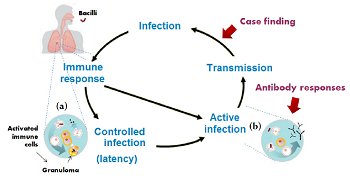Mycobacterium tuberculosis - Complications, Drug resistance, Latent TB, Treatment, AST, DST
Complications of Mycobacterium tuberculosis
Miliary disease, disseminated tuberculosis, and tuberculous meningitis caused by Mycobacterium tuberculosis are the most serious complication of primary complications of tuberculosis.
Pleural effusion and pneumothorax are other pulmonary complications of tuberculosis. Intestinal perforation, obstruction, and malabsorption are complications of tuberculosis of the small intestine. Hydronephrosis and auto nephrectomy are renal complications.
Paraplegia is the impairment in motor or sensory function of the lower extremities.
Mycobacterium tuberculosis with HIV
HIV patients with Mycobacterium tuberculosis are more likely to progress to disseminated disease. These patients usually do not have the cavitary pulmonary disease or upper lobe infiltrates in the lung.
Patients with tuberculosis should be tested for HIV and those with HIV need to be tested periodically for tuberculosis by tuberculin skin test and chest radiography. HIV patients with a positive tuberculin skin test usually develop active tuberculosis at a rate of 3-16% per year. HIV reactivates latent infection and makes the disease more serious and treatment ineffective.
The patient with both HIV and Mycobacterium tuberculosis on treatment with antiretroviral therapy develops various clinical manifestations which include fever, lymphadenopathy, and noninvasive pulmonary infiltrates.

Fig: Mycobacterium tuberculosis transmission (Source: ReaserchGate)
Drug-resistant TB
With increasing resistance to antibiotics, Mycobacterium tuberculosis can be classified as:
Mono resistant => resistant to anyone TB treatment
Poly resistant => resistant to at least 2 TB drugs (but not both isoniazid and rifamycin)
MDR TB => is resistant to at least isoniazid and rifampin, the two best first-line TB treatment drugs
XDR TB => resistant to isoniazid and rifamycin, PLUS resistant to any fluoroquinolone and at least 1 of the 3 injectable 2nd like drugs (eg. amikacin, kanamycin, or capreomycin)
Latent TB infection (LTBI) | TB disease (in the lungs) |
|---|---|
Inactive, contained tubercle bacilli in the body | Active, multiplying tubercle bacilli in the body |
Serum test or blood test results are usually positive | Serum test or blood test results are usually positive |
Chest X-ray is usually normal | Chest X-ray is usually abnormal |
Sputum smears and culture negative | Sputum smears and cultures may be positive |
No symptoms | Symptoms such as cough, fever, weight loss |
Not infectious | Often infectious before treatment |
Not a case of TB | A case of TB |
Treatment of Mycobacterium tuberculosis
The treatment of Mycobacterium tuberculosis is done by following methods:
1st line drug: Isoniazid, rifampicin, pyraziramide, streptomycin, ethambutol
2nd line drug: kanamycin, amikacin, ciprofloxacin, ofloxacin, cycloserine
DOTS method is highly effective
AST of Mycobacterium tuberculosis
MDR and XDR tuberculosis by Mycobacterium tuberculosis infection have occurred
MDR is resistant to rifampin and isoniazid (the two most effective drugs to treat tuberculosis)
XDR is resistant not only to rifampin and isoniazid but also to quinolones and other drugs such as aminoglycosides and capreomycin
Drug Susceptibility testing (DST) of Mycobacterium tuberculosis
The drug susceptibility testing (DST) of Mycobacterium tuberculosis is done as:
Used to determine the resistance of strains isolated before the commencement of treatment
DST can be demonstrated by:
phenotypic susceptibility assay
genotypic methods
Phenotypic assays include
resistance ration method
absolure concentration method
proportional method
radiometric method
Genotypic methods include
DNA sequencing
real-time PCR
microarrays
MTBDR plus assay